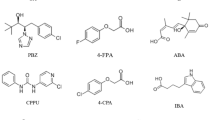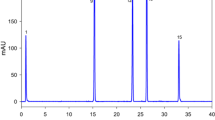Abstract
This study provides a versatile validated method to determine the total vitamin C content, as the sum of the contents of L-ascorbic acid (L-AA) and dehydroascorbic acid (DHAA), in several fruits and vegetables and its degradability with storage time. Seven horticultural crops from two different origins were analyzed using an ultra-high-performance liquid chromatographic–photodiode array (UHPLC-PDA) system, equipped with a new trifunctional high strength silica (100% silica particle) analytical column (100 mm × 2.1 mm, 1.7 μm particle size) using 0.1% (v/v) formic acid as mobile phase, in isocratic mode. This new stationary phase, specially designed for polar compounds, overcomes the problems normally encountered in HPLC and is suitable for the analysis of large batches of samples without L-AA degradation. In addition, it proves to be an excellent alternative to conventional C18 columns for the determination of L-AA in fruits and vegetables. The method was fully validated in terms of linearity, detection (LOD) and quantification (LOQ) limits, accuracy, and inter/intra-day precision. Validation experiments revealed very good recovery rate of 96.6 ± 4.4% for L-AA and 103.1 ± 4.8 % for total vitamin C, good linearity with r 2-values >0.999 within the established concentration range, excellent repeatability (0.5%), and reproducibility (1.6%) values. The LOD of the method was 22 ng/mL whereas the LOQ was 67 ng/mL. It was possible to demonstrate that L-AA and DHAA concentrations in the different horticulture products varied oppositely with time of storage not always affecting the total amount of vitamin C during shelf-life. Locally produced fruits have higher concentrations of vitamin C, compared with imported ones, but vegetables showed the opposite trend. Moreover, this UHPLC-PDA methodology proves to be an improved, simple, and fast approach for determining the total content of vitamin C in various food commodities, with high sensitivity, selectivity, and resolving power within 3 min of run analysis.




Similar content being viewed by others
References
Nováková L, Solich P (2008) HPLC methods for simultaneous determination of ascorbic and dehydroascorbic acids. TraC Trends Anal Chem 27(10):942–958
Johnston CS, Bowling DL (2007) Ascorbic acid. In: Handbook of vitamins. 4 edn. CRC Press, Boca Raton
Phillips KM, Tarragó-Trani MT (2010) Stability of vitamin C in frozen raw fruit and vegetable homogenates. J Food Compos Anal 23(3):243–259
Eitenmiller RR, Ye L, Landen Jr WO (2008) Ascorbic acid: vitamin C. In: Vitamin analysis for the health and food sciences, 2 edn. CRC Press, Boca Raton
Fenoll J, Martínez A (2011) Simultaneous determination of ascorbic and dehydroascorbic acids in vegetables and fruits by liquid chromatography with tandem-mass spectrometry. Food Chem 127(1):340–344
Naidu KA (2003) Vitamin C in human health and disease is still a mystery? An overview. Nutr J 2:7
Davey MW, Montagu MV (2000) Plant L-ascorbic acid: chemistry, function, metabolism, bioavailability and effects of processing. J Sci Food Agric 80(7):825–860
Valente A, Albuquerque TG (2011) Ascorbic acid content in exotic fruits: a contribution to produce quality data for food composition databases. Food Res Int 44(7):2237–2242
Odriozola-Serrano I, Hernández-Jover T (2007) Comparative evaluation of UV-HPLC methods and reducing agents to determine vitamin C in fruits. Food Chem 105(3):1151–1158
Lee SK, Kader AA (2000) Preharvest and postharvest factors influencing vitamin C content of horticultural crops. Postharvest Biol Technol 20(3):207–220
Hernández Y, Lobo MG (2006) Determination of vitamin C in tropical fruits: a comparative evaluation of methods. Food Chem 96(4):654–664
Frenich AG, Torres ME (2005) Determination of ascorbic acid and carotenoids in food commodities by liquid chromatography with mass spectrometry detection. J Agric Food Chem 53(19):7371–7376
Quirós AR-B, Fernández-Arias M (2009) A screening method for the determination of ascorbic acid in fruit juices and soft drinks. Food Chem 116(2):509–512
Sánchez-Mata MC, Cámara-Hurtado M (2000) Comparison of high-performance liquid chromatography and spectrofluorimetry for vitamin C analysis of green beans (Phaseolus vulgaris L.). Eur Food Res Technol 210(3):220–225
Lykkesfeldt J (2000) Determination of ascorbic acid and dehydroascorbic acid in biological samples by high-performance liquid chromatography using subtraction methods: reliable reduction with Tris[2-carboxyethyl]phosphine hydrochloride. Anal Biochem 282(1):89–93
Nováková L, Solichová D (2009) Hydrophilic interaction liquid chromatography—charged aerosol detection as a straightforward solution for simultaneous analysis of ascorbic acid and dehydroascorbic acid. 0021-9673 1216 (21):4574–4581
Swartz ME (2005) Ultra performance liquid chromatography (UPLC): an introduction. http://chromatographyonline.findanalytichem.com/lcgc/data/articlestandard//lcgc/242005/164646/article.pdf. Accessed 20 June 2011
Paliakov EM, Crow BS (2009) Rapid quantitative determination of fat-soluble vitamins and coenzyme Q-10 in human serum by reversed phase ultra-high pressure liquid chromatography with UV detection. J Chromatogr B 877(1–2):89–94
Granado-Lorencio F, Herrero-Barbudo C (2010) Suitability of ultra-high performance liquid chromatography for the determination of fat-soluble nutritional status (vitamins A, E, D, and individual carotenoids). Anal Bioanal Chem 397(3):1389–1393
Li X, Franke AA (2009) Fast HPLC-ECD analysis of ascorbic acid, dehydroascorbic acid and uric acid. J Chromatogr B 877(10):853–856
Campos FM, Ribeiro SMR (2009) Optimization of methodology to analyze ascorbic and dehydroascorbic acid in vegetables. Quim Nova 32:87–91
Franke AA, Custer LJ (2004) Vitamin C and flavonoid levels of fruits and vegetables consumed in Hawaii. J Food Compos Anal 17(1):1–35
González-Molina E, Moreno DA (2009) Comparison of ‘Verna’ lemon juice quality for new ingredients and food products. Sci Hortic 120(3):353–359
Koh E, Wimalasiri KMS (2009) Content of ascorbic acid, quercetin, kaempferol and total phenolics in commercial broccoli. J Food Compos Anal 22(7–8):637–643
Vallejo F, Tomás-Barberán FA (2002) Potential bioactive compounds in health promotion from broccoli cultivars grown in Spain. J Sci Food Agric 82(11):1293–1297
Vasco C, Ruales J (2008) Total phenolic compounds and antioxidant capacities of major fruits from Ecuador. Food Chem 111(4):816–823
Zeraik ML, Pereira CAM (2010) Maracujá: um alimento funcional? Rev Bras Farmacogn 20:459–471
Zhang HY (2003) Phenolic compounds, ascorbic acid, carotenoids and antioxidant properties of green, red and yellow bell peppers. J Food Agric Environ 2:22–27
Zhang D, Hamauzu Y (2004) Phenolics, ascorbic acid, carotenoids and antioxidant activity of broccoli and their changes during conventional and microwave cooking. Food Chem 88(4):503–509
Marín A, Ferreres F (2004) Characterization and quantitation of antioxidant constituents of sweet pepper (Capsicum annuum L.). J Agric Food Chem 52(12):3861–3869
Martínez S, López M (2005) The effects of ripening stage and processing systems on vitamin C content in sweet peppers (Capsicum annuum L.). Int J Food Sci Nutr 56(1):45–51
Pérez-López AJ, del Amor FM (2007) Influence of agricultural practices on the quality of sweet pepper fruits as affected by the maturity stage. J Sci Food Agric 87(11):2075–2080
Food and Nutrition Board IoM, National Academics dietary reference intakes (DRIs): estimated average requirements for groups. http://iom.edu/Activities/Nutrition/SummaryDRIs/∼/media/Files/Activity%20Files/Nutrition/DRIs/RDA%20and%20AIs_Vitamin%20and%20Elements.pdf. Accessed 27 June 2011
Acknowledgments
The authors show their gratitude to Sonae MC for supplying the fruits and vegetables samples used in this study. This research was supported by Fundação para a Ciência e a Tecnologia (FCT) with funds from the Portuguese Government (Project PEst-OE/QUI/UI0674/2011).
Author information
Authors and Affiliations
Corresponding author
Additional information
Published in the special issue Euroanalysis XVI (The European Conference on Analytical Chemistry) with guest editor Slavica Ražić.
Rights and permissions
About this article
Cite this article
Spínola, V., Mendes, B., Câmara, J.S. et al. An improved and fast UHPLC-PDA methodology for determination of L-ascorbic and dehydroascorbic acids in fruits and vegetables. Evaluation of degradation rate during storage. Anal Bioanal Chem 403, 1049–1058 (2012). https://doi.org/10.1007/s00216-011-5668-x
Received:
Revised:
Accepted:
Published:
Issue Date:
DOI: https://doi.org/10.1007/s00216-011-5668-x




